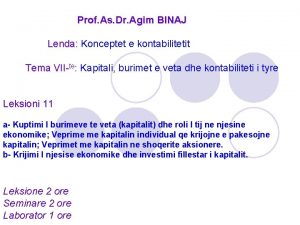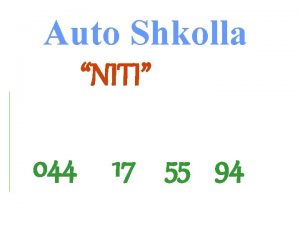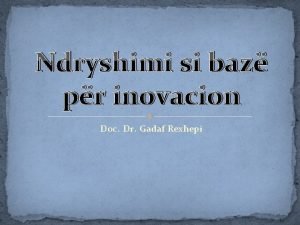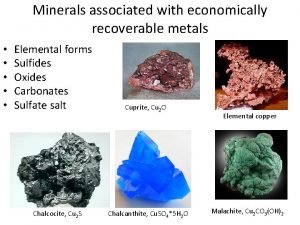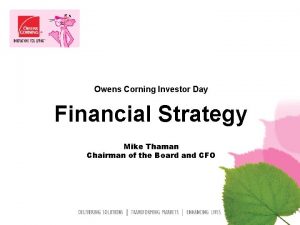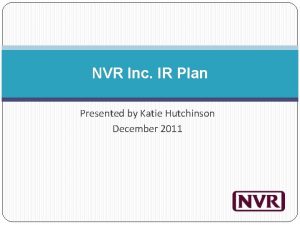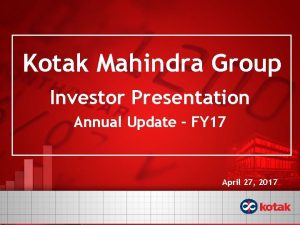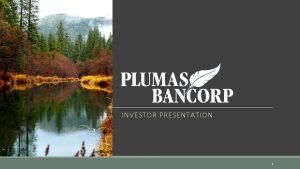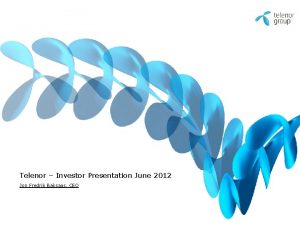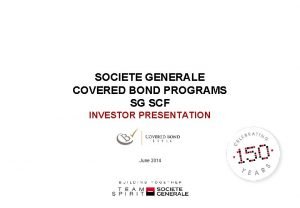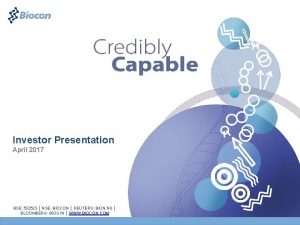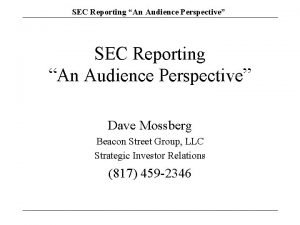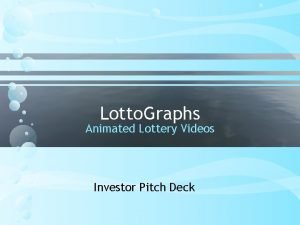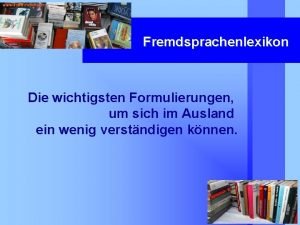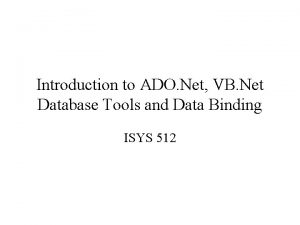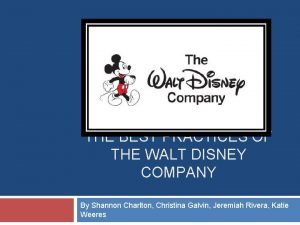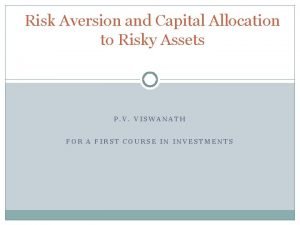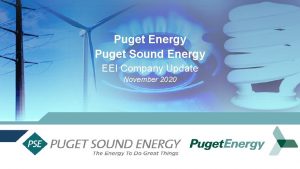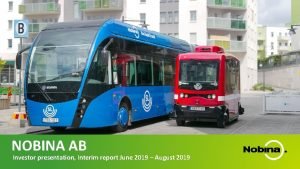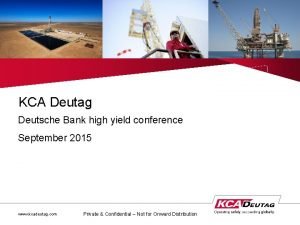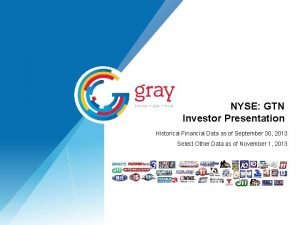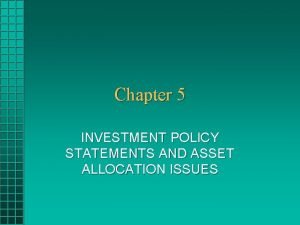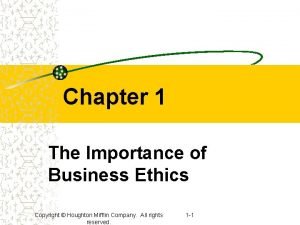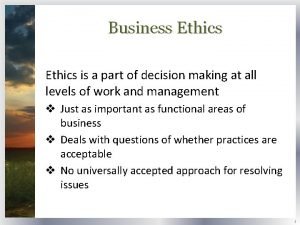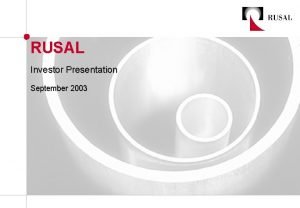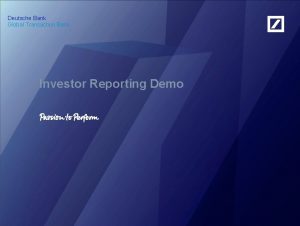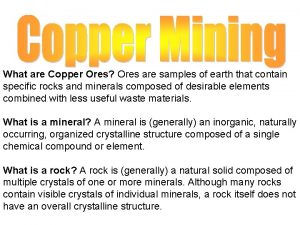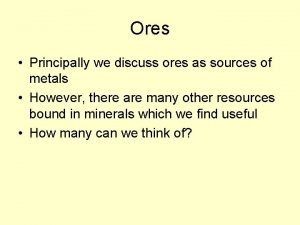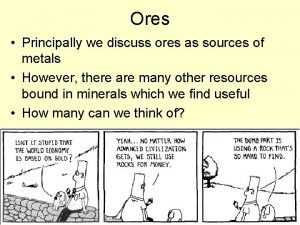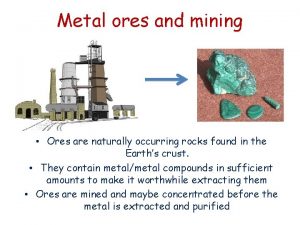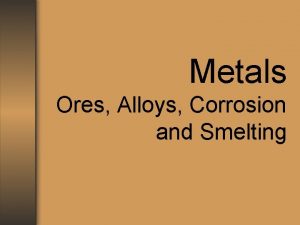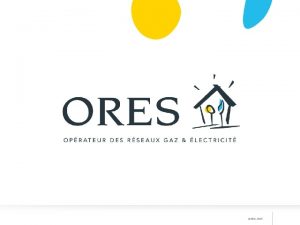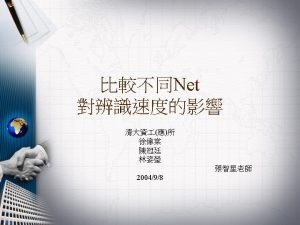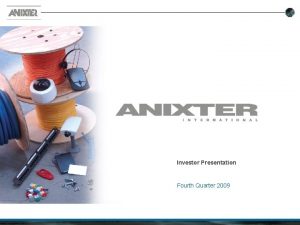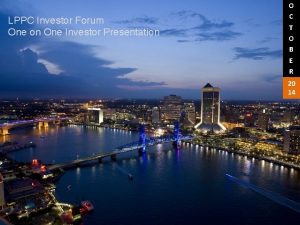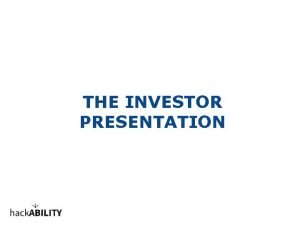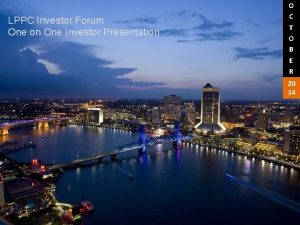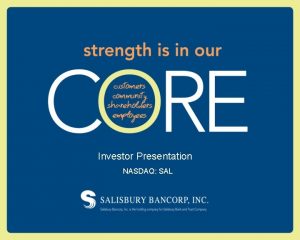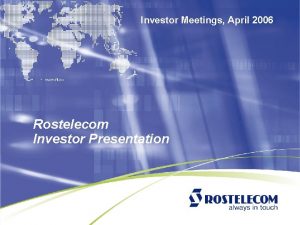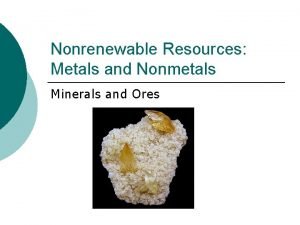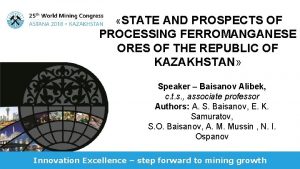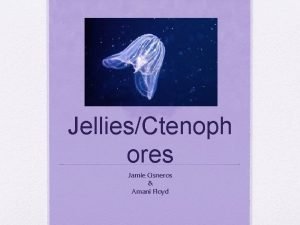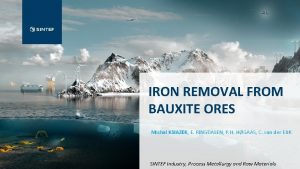ores net Investor Presentation 2014 Investor presentation 2014



















































- Slides: 51

ores. net

Investor Presentation 2014 Investor presentation – 2014 2

Disclaimer This presentation contains confidential information and none of its content (or any part thereof) may be modified, reproduced or distributed to any other person in any form or by any means, directly or indirectly, without the prior written consent of ORES s. c. r. l. The term ORES refers either to ORES s. c. r. l. (parent company) or to ORES Assets, the Walloon mixed Distribution System Operator (DSO), ORES and its subsidiaries Indexis and Atrias. Forward-looking statements in this presentation do not guarantee future performance. Actual results may differ materially from such forward-looking statements as a result of a number of uncertainties or risks, many of which are out of control of ORES, its subsidiaries and shareholders. Forward-looking statements speak only as at the date of this document. The information contained in this presentation is subject to amendment, revision and updating. It is in no way an investment advice or a recommendation to subscribe or purchase any securities. Investor presentation – 2014 3

Table of contents 1. Executive summary 2. Company and business overview 3. Regulatory framework 4. Financials 5. Risk Management 6. Challenges 7. Appendix Investor presentation – 2014 4

1. Executive Summary Key investment considerations Strategicimportanceto tothe the. Walloon Region Legalmonopolisticbusiness Legal Regulatedbusinessand andpredictable Regulated cash flow generation Strongbalancesheetstructure ORES actsoperating as a singlestructure entity for all mixed Efficient Ø Ø ORES/ORES Assets cover about 76% of the municipalities in Wallonia ORES ensures energy distribution to more than 1, 4 mio homes and small businesses in Wallonia on a daily basis Ø ORES has a legally based regional monopoly for electricity and gas distribution to residential customers and small and medium size companies including public servicesobligations. Ø Lower business risk – ORES is not involved in the competitive generation and trading Activities performed by ORES are regulated Ø Ø Ø Relatively strong balance sheet structure Low financial leverage (RAB is financed with 50% of equity while the regulator recommends 33%) Ø Merger of the 8 mixed DSO by creation of ORES Assets in 2013, operating as a single mixed DSO in Wallonia 5

Table of contents 1. Executive summary 2. Company and business overview 3. Regulatory framework 4. Financials 5. Risk Management 6. Challenges 7. Appendix Investor presentation – 2014 6

2. Company and business overview Investor presentation – 2014 7

Table of contents • • Shareholders’ structure of ORES in a nutshell Missions of ORES/ORES Assets Key considerations Some 2013 highlights RAB in constant evolution A network of quality What’s behind tariffs ? Investor presentation – 2014 8

Shareholders’ structure of ORES Potential exit of Electrabel Municipalities (197 -15, 79%) Intermunicipalities (7 - 59, 21%) § Electrabel has a put option for its residual GDF Suez (Electrabel) stakes in ORES Assets that can be exercised from January 1, 2019 to June 30, 2019 Distribution System Operator (DSO) 75 % § Legal monopolistic position for the area 25 % covered by its network § Legal status of company of public law § Owner of the assets § No employees § No non-regulated activities § The expiry date of the mandate for ORES Assets is in 2025 ORES Assets Operational Management § No assets § Sole employer of the Group § All operations at cost price except for ORES products and services 17% Atrias 30 % Indexis 14 % N’Allo Investor presentation – 2014 Subsidiaries § Atrias : federal clearing house for the improvement and simplification of data exchange § Indexis : service provider, on behalf of DSOs grouped in Eandis and ORES, for processing and exchanging data between different market players in the energy market § N’Allo : support customer service, sales strategy and marketing of its customers 9

ORES in a nutshell ELECTRICITY NATURAL GAS 50. 756 9. 003 Distributed energy (MWh) 11. 780. 040 13. 932. 346 Access points 1. 439. 481 530. 585 2. 194. 307. 041 997. 097. 592 2013 figures Network length (km) RAB (€) Geographical presence Mixed DSOs in Wallonia Investor presentation – 2014 10

Missions of ORES/ORES Assets Operating distribution grids Take care of the day-to-day operation of the electricity and natural gas distribution grids as well as the municipal public lighting network Connection work (1) Establish new connections to the networks that ORES operates (2) Adapt existing networks, as well as fitting and reinforcing meters Meter reading and consumption data management Public service obligations Management of access register New Products & Services Read meters of over 1. 4 million clients and manage this information under conditions of strict confidentiality (1) Provide energy supplies for protected clients wishing to receive their power from their grid operator (2) Match budget meters at the request of energy suppliers for clients whose energy bills are outstanding (3) Take care of operating and maintaining public lighting in the municipalities and promoting the energy efficiency of the lighting facilities (4) Qualiwatt and tomorrow progressive tariff Keep technical data on more than 1, 9 million connections up to date in the ‘access register’ which contains the administrative details of customers and their energy suppliers With unbundled accounting. For example electric vehicle charging stations, CNG installation… Investor presentation – 2014 11

Key considerations Strategic importance to the Walloon Region • ORES and DSO provide number of Public Service Obligations (65 757 €k in 2013) : social PSO, public lighting, … and more recent Qualiwatt for photovoltaïc Legal monopolistic business • DSO has a legally based regional monopoly for electricity and gas distribution to residential customers and small and medium size companies • Lower business risk – DSO is not involved in the competitive generation, trading and sales activities except for some marginal products and services Regulated business and predictable cash flow generation • Activities performed by ORES are regulated • Predictable revenue of DSOs is priced on a cost plus basis, determined in a legal framework • Current regulatory tariffs were prolonged for 2 years (2013 -2014) by decision of the regulator (CREG) Strong balance sheet structure ORES acts as a single entity for ORES Assets in Wallonia Efficient operating structure • Relatively strong balance sheet structure • Low financial leverage (RAB is financed 50% of equity while the regulator recommends 33%) • Efficient operating structure • Aiming at being a company for people and involved in the future of the Walloon Region Investor presentation – 2014 12

Some 2013 highlights… (1/2) • Merger of the 8 mixed DSOs creation of ORES Assets • Splitting DSO Intermosane 1 (city of Liège) and 2 and merger Intermosane 1 within Tecteo-Resa • 2. 271 FTE on 31 December 2013 (2. 313 FTE in 2012) • 2013 net investments on distribution network : 120 €m for electricity and 71 €m for gas • Annually recapitalization of ORES Assets for 10. 5 €m (in cash) • Management in 2013 of more than 25. 000 new files about renewable electricity power photovoltaic (40. 000 in 2012) Investor presentation – 2014 13

Some 2013 highlights… (2/2) • Tomorrow’s distribution network: smart grids and smart meters (pilot projects, studies, GAD, flexibility, etc) • Discussions with the Governement about new public service obligations: finalisation of a progressive tariff, Qualiwatt (new subsidy mechanism for individual photovoltaic power), banking of green power certificates and tax exemption for industrials low financial impacts on ORES Assets (less than 5 €m in 2014) • ‘ORES vision 2020’ project: brainstorming on new potential activities (charging electric vehicles station, CNG installation, etc). Investor presentation – 2014 14

RAB* in constant evolution… (€k) 2, 500, 000 2, 000 1, 500, 000 Electricity Gas 1, 000 500, 000 0 2009 2010 2011 2012 2013 * Regulated Asset Base Investor presentation – 2014 15

A network of quality… ORES data : - Total SAIDi min : 59 Rate of uc MV : 78, 5% Rate of uc LV: 27, 5% Saidi = average duration of energy disruption of an average final consumer in the supply area of the DSO during a given period Graphic extracted from : 5 th CEER benchmarking report on thee quality of electricity supply 2011 Investor presentation – 2014 16

What’s behind tariffs ? Distribution tariffs – Electricity Overall cost Distribution tariffs (ex IEH) - 2013 - LV 6% 16% 72% 29% Excludin g VAT 28 % Manageable costs Non-manageable costs PSO 15% Capex REMCI 11% Investor presentation – 2014 Financial charges 23% 17

What’s behind tariffs ? Distribution tariffs – Gas Overall cost Distribution tariffs (ex IGH) - 2013 LP 12% 24% 17% 73% Manageable costs Excludin g vat 27 % Non-manageable costs PSO Capex 16% REMCI Financial charges 18% 15% Investor presentation – 2014 18

What’s behind tariffs ? Distribution and transport tariffs – Electricity Comparaison des composantes des tarifs de distribution et de transport par domaine de tension, clients-type Secteur Hainaut 100. 00 tarifs 2013, euro/MWh 91. 54 90. 00 3. 35 80. 00 18. 15 66. 90 70. 00 60. 00 50. 00 10. 41 2. 43 2. 61 7. 04 16. 5 13. 3 40. 00 2. 59 30. 00 49. 98 20. 00 32. 08 10. 00 Dégressivité du tarif Total Cotisation fédérale 38. 93 2. 28 30. 92 16. 5 2. 24 PME Ic 1 160 MWh, MT Redevance de voirie (distribution) OSP 16. 17 7. 85 2. 59 9. 71 Résidentiel Dc, BT total coûts soutien aux énergies renouvelables Total coûts de transport Petit ind. 5 GWh, MT 9. 27 2. 59 0. 650000003 Moyen ind. GWh Trans-MT 25 source: ORES sur base des grilles tarifaires des gestionnaires de réseau -2013 profil de consommation : résidentiel Dc, 3500 k. Wh/an (1600 k. Wh Hp et 1900 k. Wh Hc) , PME Ic 1 160 MWh (135 MWh le jour et 25 MWh la nuit ), Petit Ind. 5 GWh (2. 5 GWh le jour et 2. 5 GWh la nuit) , client industriel Moyen 25 GWh (13. 5 GWh le jour et 11. 5 GWh la nuit) Investor presentation – 2014 19

Table of contents 1. Executive summary 2. Company and business overview 3. Regulatory framework 4. Financials 5. Risk Management 6. Challenges 7. Appendix Investor presentation – 2014 20

3. Regulatory framework Investor presentation – 2014 21

The energy regulation, same as the institutional landscape of Belgium § Energy distribution is a regional competence, except for the tariff competence which is still federal competence today in Belgium …however, based on the latest institutional agreements (end of 2011) and the special law of 6 January 2014, the regionalisation of the tariff competence will be effective in July 2014 § The federal regulator (CREG) is competent for tariff setting (definition of tariff methodology, tariff approval and controle ex-ante and expost) § The regional regulator in Walloon Region (CWa. PE - Commission Wallone Pour l’Energie) is in charge of technical regulations, local distribution of electricity and natural gas, execution of social public service obligations, approval of investments program, and soon (01/07/14) for tariff setting Investor presentation – 2014 22

Evolution of the regulatory framework… Before 2012 • Total network income is guaranteed for a regulatory period of 4 years that is adequate to cover the tasks set by law and allows for a reasonable profit margin in return for the capital invested in the network • The income from each year of the regulatory period is divided into “manageable costs” and “non-manageable costs”: • Manageable costs : a factor for productivity and efficiency improvements is applied. In addition, the network operator is offered an incentive that increases profits by means of the balance of the manageable costs • Non-manageable costs : differences relating to non-manageable costs (ex: financial charges) and to volumes of transported energy are considered as a global liability or receivable towards the customers • 3 rd Energy Package (European Directive) transposed in Belgian law (federal –still in project in Wallonia (transposed in 2014)) 2012 2013 -2014 As from 2015 • Decision to prolong the tariffs in 2013/2014 • A decree give, from 01. 07. 2014, the competence to the CWa. PE for the approval of the regulatory balance since 2010 … and for the allocation forward in the tariffs of the regulatory balance since 2008 • Transitional period 2015 -2016 with a new methodology but without substantial change : ensure continuity of the regulatory framework set up at federal level - after consultation document, a ‘note préparatoire’ is approved on 06. 02. 14 • Next period (5 years) 2017 -2021 : evolution of the regulatory framework is unclear Investor presentation – 2014 23

Tariff 2015 -2016 – Key features q Tariffs must aim at § § § Being non-discriminatory and transparent Being fixed relative to costs and enabling the network operator to cover its costs incurred in the framework of its regulated activities, incl. financial charges Including a fair beneficiary margin for the remuneration of the capital invested in the network with a view to ensure its optimal development q 3 objectives of the tariff methodology for 2015 -2016 (note that there’s no definitive methodology before July 2014): § Curb tariff budget envelope § Ensure developement of grids § Establish a stable regulatory framework q Cost oriented mechanism q Formula Operational costs + Depreciation & Amortization + Financial charges + Taxes paid + Return On Invested Capital = Tariff Estimated booked capacity Investor presentation – 2014 24

Tariff 2015 -2016 – Key features q Differentiation between primary regulatory asset base (investments before 2014) and secondary regulatory asset base (investments from 2014) § § Net working capital no longer included in RAB Global ROI unchanged q Manageable costs 2015 -2016 = indexed actuals 2012 § Special envelope for clearing house and smart grid q Application of Grid fee on gross withdrawn energy § To take prosumers into account Investor presentation – 2014 25

Table of contents 1. Executive summary 2. Company and business overview 3. Regulatory framework 4. Financials 5. Risk Management 6. Challenges 7. Appendix Investor presentation – 2014 26

4. Financials Investor presentation – 2014 27

Summary financials 2013 (actuals) Economic Group ORES/DSO (IFRS) In €m Income statement Total operating income (Turnover and other operating income including rate rgulated balances) 2013 1. 107 2012 Balance sheet 959 Total Current Assets incl. CASH 2013 2012 504 580 209 285 EBITDA 387 398 Total Non Current Assets 3. 365 3. 254 EBIT 258 275 Total Assets (excluding rate 3. 869 3. 834 Financial Result -70 -75 Total Assets 3. 956 4. 072 Net Profit 183 199 Financial debt 1. 937 2. 046 Global Income Profit Result 270 135 Total Shareholders’ Equity 1. 582 1. 438 Total Liabilities & Equity 3. 938 3. 968 Total Liabilities & Equity 3. 956 4. 072 regulated balances) (excluding rate regulated balances) Investor presentation – 2014 28

2014 Indicative funding needs In €m / 2014 Gross investments Net investments (-) Electricity 171 123 Gas 82 78 (after “interventions clients”) Depreciations (+) Funding needs (=) Total 90 33 40 38 71 (+) Refinancing existing debt + 109 Unconsumed budget 2013 - 34 Financing needs = 146 Cash available -> 146 Total financing needs = (+) 0 Investor presentation – 2014 29

Indicative long term funding needs In €m 300 250 200 Smart 150 Gas 100 Electricity 50 0 2015 2016 2017 2018 • Above mentioned figures are showing total indicative financing needs for new investments : CAPEX (including “smart”) > Depreciation + refinancing of existing debt • Above mentioned indicative investment program has not been yet approved by the CWa. PE and by the board of directors • Financing sources: Bank loans, Bond and Medium Term Notes Investor presentation – 2014 30

Debt management (1/2) Evolution of the debt 2, 500 2. 112 2, 000 1, 500 350 190 1. 933 62 117 350 190 Bond CP private loans 1, 000 1, 572 1, 393 500 0 Debt outstanding Transfer of Refund in capital 2012 Intermosane 1's debt bank loans towards Tecteo Debt outstanding 2013 Investor presentation – 2014 bank loans Debt average rate of interest in 2013 =3, 43% 31

Debt management (2/2) Millions Debt maturity profile 2, 500 € 12. 0% 9. 6% 10. 0% 8. 7% 2, 000 € 7. 9% 1, 500 € 6. 2% 8. 0% 6. 0% 5. 5% 6. 0% Depreciation/debt other loans bank loans 1, 000 € 4. 0% 500 € 2. 0% -? ? € 0. 0% 2013 2014 2015 2016 2017 2018 2019 Debt average duration : 6 years 9 months Investor presentation – 2014 32

Funding sources (01 january 2014) • Total size programs : CP Programs Undrawn Credit Lines Private Placement (9 y - issued in 2012) 250 €m • 1) currently medium term outstanding : 189 €m • 2)currently short term outstanding : 0€ • Project : new CP Program : 500 €m • Total size facilities : • Currently outstanding : 100 €m 0€ • Initial amount : • Remaining in cash : 350 €m 160 €m Investor presentation – 2014 33

Financial policies and strategy DSO financial policies • Dividend payout ratio is about 90% in B-Gaap • Funds are borrowed by ORES on behalf of DSO • ORES Assets guarantees the debt Funding currency • External funding in € only Risk management policies • Interest rate swap and cap agreements are used for hedging purposes only Rating /EMTN • Proposal, by the management to the board of directors, to provide a rating for the economic group ORES at the end of 2014 and to finalize an EMTN program of 4 Mia € Investor presentation – 2014 34

Table of contents 1. Executive summary 2. Company and business overview 3. Regulatory framework 4. Financials 5. Risk Management 6. Challenges 7. Appendix Investor presentation – 2014 35

5. Risk Management Investor presentation – 2014 36

A limited commercial risk… Customers of the DSO financial flows in 2013 – – 30 suppliers (grid fee) : 970 €m (more than 97% of turnover) Consumers (intervention for connection ) : 56 €m = turnover in IFRS Social consumers (for consumption of energy) : 19 €m Varia (Tecteo, etc) From poducers to consumer – payment flows Producer Supplier Transporter Consumer Distributor Investor presentation – 2014 37

A predictable regulatory risk … • Finalization of the new methodology 2015 -2016 • Further discussion on a new methodology for 2017 ? • Acceptance of the prosumers in the methodology • Allocation of the actual regulatory balance for the next regulatory periods Investor presentation – 2014 38

Electricity Cumulated regulatory balance Investor presentation – 2014 39

Gas Cumulated regulatory balance Investor presentation – 2014 40

A possible equity risk … New opportunities ? • Put of Electrabel : possible exit in 2019 ? • Capacity of the municipalities to continue investing in electricity and gas grid New shareholders with the public majority support ? Investor presentation – 2014 41

A possible interest rate risk… 2013 debt profile Fixed 75% Variable 13% Increase in market rates of 1% : impact +0, 02% Other 12% 04/11/2020 Investor presentation – 2014 42

Table of contents 1. Executive summary 2. Company and business overview 3. Regulatory framework 4. Financials 5. Risk Management 6. Challenges 7. Appendix Investor presentation – 2014 43

6. Challenges Investor presentation – 2014 44

Main challenges for ORES • Maintain high network reliability with high penetration of renewables By 2020, renewable energy should account for 40% of the electric demand • Need for increased capital expenditure ü to connect renewables ü to allow an active distribution system management (deal with increased volatility of flows) ü to invest in SMART • Keep energy affordable (<>increased capital expenditures and decreasing volumes) and avoid discriminations between users • Internal challenge: vision 2020 project - focus on corporate culture Investor presentation – 2014 45

Key success factors • Need for a stable and predictable energy policy • Need for regulatory arrangements that : ü incentivise active demand management options ü promote innovation ü integrate a premium on regulated WACC to attract new investors • Need for transparent tariffs to facilitate acceptance and comprehension (indentify clearly the different costs components, taxes and public service obligations) • Tariffs should be cost-causal, non discriminatory and progressively replace ‘exclusively volumetric tariffs’, by adding a capacity charge Investor presentation – 2014 46

Table of contents 1. Executive summary 2. Company and business overview 3. Regulatory framework 4. Financials 5. Risk Management 6. Challenges 7. Appendix Investor presentation – 2014 47

6. Appendix Investor presentation – 2014 48

Capex Electricity and Gas In €k Investments 2015 – 2018 (not yet approved by CWa. PE) 300000 250000 TOTAL Smart 200000 TOTAL Extra [Building - SW] TOTAL Off network [as usual] TOTAL Network ELEC [Net - as usual] TOTAL Network GAS [Net as usual] 150000 100000 50000 0 2015 2016 2017 2018 Investor presentation – 2014 49

What’s behind tariffs ? Evolution of components of the tariff (1/2) for residentials – Electricity Evolution de la facture totale d'électricité, par composantes, IEH -client-type Dc 3500 k. Wh/an bi horaire , en euro/an 800. 00 Total facture TVAC prix déflatés 618. 50 661. 13 630. 93 651. 18 686. 07 684. 36 124. 70 124. 25 28. 96 35. 38 23. 36 61. 15 704. 47 700. 00 600. 00 500. 00 113. 57 17. 57 18. 20 120. 70 17. 80 21. 11 115. 46 118. 85 127. 68 21. 46 20. 32 25. 14 25. 51 29. 85 250. 44 262. 16 289. 06 271. 91 29. 43 28. 80 27. 82 28. 04 30. 71 190. 14 186. 01 180. 16 175. 64 173. 80 année 2011 année 2012 année 2013 99. 68 400. 00 300. 00 272. 14 300. 12 200. 00 33. 84 40. 21 100. 00 163. 19 161. 18 251. 14 0. 00 année 2007 année 2008 année 2009 -le client Dc a une consommation moyenne de 3500 k. Wh/an repartie en 1600 k. Wh/an Hp et 1900 k. Wh/an Hc, -la partie énergie a été calculée en utilisant les données et les offres du fournisseur Electrabel, Energyplus coûts distrib. +OSP+pertes cotisation sur l'énergie +TVA cotisation fédérale et autres prél. pub soutien aux énergies vertes énergie coûts transport hors prél. pub pertes de réseau (distribution) OSP (distribution) coûts distribution hors prél. pub Support for green energy causes the increase of the energy bill Investor presentation – 2014 50

What’s behind tariffs ? Evolution of components of the tariff for residentials – Gas 1, 800. 00 1, 400. 00 1, 200. 00 1, 000. 00 1, 322. 02 307. 75 16. 08 1, 496. 06 12. 59 1, 161. 01 222. 29 14. 22 252. 64 12. 52 1, 017. 01 779. 57 1, 582. 10 1, 400. 76 1, 337. 12 251. 77 581. 24 728. 55 278. 90 55. 33 292. 66 56. 77 261. 66 52. 68 822. 29 898. 51 755. 75 coûts de distribution OSP comprises et hors prél. pub. cotisation sur l'énergie et TVA cotisation fédérale et autre prél. Pub. énergie 400. 00 200. 00 total 1, 651. 71 800. 00 600. 00 Evolution de la facture totale du gaz, par composantes, GRDs-ORES, résidentiel client-type T 2, en euro/an prix déflatés 1, 600. 00 (2/2) 37. 22 35. 61 30. 29 30. 51 31. 58 30. 70 30. 38 240. 88 275. 26 312. 97 312. 89 307. 97 303. 46 300. 28 année 2007 année 2008 année 2009 année 2010 année 2011 année 2012 année 2013 coûts de transport 0. 00 -le client T 2 a une consommation moyenne de 23. 260 k. Wh/an , -pour les coûts des reseaux de distribution une moyenne pondérée des GRDs- ORES a été calculée pour chaque année ; -les coûts de transport on été estimé au niveau des coûts publiés par la CREG dans son rapport du septembre 2013 sur les prix et sur les composantes; -la partie énergie a été calculée en utilisant les données de la CREG et les offres du fournisseur Electrabel, Energyplus Energy component highly determines bill’s evolution Investor presentation – 2014 51
 Mjetet mesimore
Mjetet mesimore Kuptimi i ores
Kuptimi i ores Shpjegimi i ores
Shpjegimi i ores Rruga nderkombetare shenja
Rruga nderkombetare shenja Kuptimi i ores
Kuptimi i ores Kuptimi i ores
Kuptimi i ores Metodat e mesimdhenies
Metodat e mesimdhenies Fazat e ores mesimore
Fazat e ores mesimore Cuando ores perdona a tu hermano
Cuando ores perdona a tu hermano Site:slidetodoc.com
Site:slidetodoc.com Minerals
Minerals Planifikimi i ores mesimore matematike
Planifikimi i ores mesimore matematike Dow corning investor relations
Dow corning investor relations Qa ceo paul
Qa ceo paul Walmart investor presentation
Walmart investor presentation Organisational structure of kotak mahindra bank
Organisational structure of kotak mahindra bank Chuck moran skillsoft
Chuck moran skillsoft Johnson matthey investor presentation
Johnson matthey investor presentation Pear therapeutics investor presentation
Pear therapeutics investor presentation Disclaimer investor presentation
Disclaimer investor presentation Telenor investor relations
Telenor investor relations Societe generale investor presentation
Societe generale investor presentation Trulieve investor presentation
Trulieve investor presentation Biocon share price
Biocon share price Neuland labs investor presentation
Neuland labs investor presentation Beacon street group investor presentation
Beacon street group investor presentation Lottery.com investor presentation
Lottery.com investor presentation Investor presentation disclaimer
Investor presentation disclaimer Amway ppt presentation 2014
Amway ppt presentation 2014 Achmed lach net ich krieg mein tach net
Achmed lach net ich krieg mein tach net Ado.net vb.net
Ado.net vb.net Occipital brow presentation
Occipital brow presentation Vertex presentation
Vertex presentation Walt disney company investor relations
Walt disney company investor relations What shape is the utility of a risk-averse investor?
What shape is the utility of a risk-averse investor? Puget sound energy investor relations
Puget sound energy investor relations Investor deck ejemplos
Investor deck ejemplos östergötatrafik
östergötatrafik Deutsche bank high yield
Deutsche bank high yield Gtn investor relations
Gtn investor relations Infosys investor relations
Infosys investor relations First cash investor relations
First cash investor relations Investor life cycle
Investor life cycle Investor life cycle
Investor life cycle Business ethics chapter 1
Business ethics chapter 1 Business ethics contributes to investor loyalty
Business ethics contributes to investor loyalty Fred rockwell
Fred rockwell Bdsi investor relations
Bdsi investor relations Millionaire real estate investor worksheets
Millionaire real estate investor worksheets Rusal investor relations
Rusal investor relations Husky injection molding buffalo ny
Husky injection molding buffalo ny Deutsche bank investor reporting
Deutsche bank investor reporting

